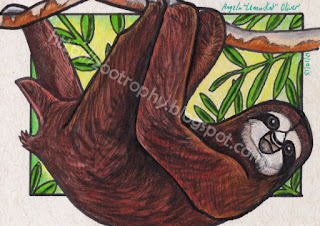About the Project
The ZooTrophy Animal-a-Day project began on October 15th, 2013 as illustrator Angela "LemurKat" Oliver began working her way, systematically but selectively, through the alphabet and presenting, via social media, an illustrated animal to the world. Daily.
All pieces are drawn as 2.5 x 3.5 inch collectible cards, using a combination of polychromos and prismacolor pencils, along with other art materials. Many are still available for purchase ($10) or trade, so drop her an email if anything captures your eye or if there is an animal you wish to request.
It is predicted this project will take her at least two years to complete - with approximately 36 animals being drawn for each letter. She has also used the images to create a collectible hardback encyclopedia series, playing cards and a desk calendar, as well as the ZooTrophy collectible trading card game.
All pieces are drawn as 2.5 x 3.5 inch collectible cards, using a combination of polychromos and prismacolor pencils, along with other art materials. Many are still available for purchase ($10) or trade, so drop her an email if anything captures your eye or if there is an animal you wish to request.
It is predicted this project will take her at least two years to complete - with approximately 36 animals being drawn for each letter. She has also used the images to create a collectible hardback encyclopedia series, playing cards and a desk calendar, as well as the ZooTrophy collectible trading card game.
Monday, October 19, 2015
#703: Sloth
The Sloth lives life slowly. There are six species, divided into three-toed and two-toed. Like their relatives, the Anteaters, the Sloth has highly specialised claws. These act as hooks, and will hold him onto the tree branch, even if he is shot from below. The Sloth's diet constists mostly of leaves, which are low energy and are difficult to digest - hence one reason why he is noted for being somewhat lethargic. As much as two-thirds of his body weight can be undigested food - and this can take over a month for his stomach to process. His sluggish nature also permits him to avoid predation, since he is also well camouflaged. Once a week he descends his tree to defecate in the same spot, digging a hole and covering it afterwards.
Labels:
mammal,
rainforest,
South America
Subscribe to:
Post Comments (Atom)


No comments:
Post a Comment